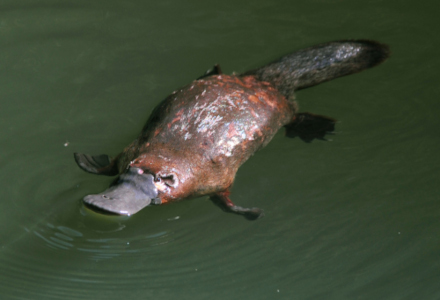
Platypus Facts
- This bizarre looking creature most frequently goes by the simple name of Platypus, and ranks as one of the most unusual animals on earth. It also sometimes goes by the alternate common name of the Duckbill Platypus, for wholly understandable reasons.
- Researchers, meanwhile, have a much more complicated term used to refer to the animal. That’s because the official scientific name for the species is a true tongue-twister. Scientists use the formal name for the marvel; Ornithorhynchus anatinus.
- By either of these terms, though, it’s a truly distinctive creation of evolution. The respected English botanist and zoologist, George Kearsley Shaw made the first recognition of it as a separate and distinct species. This event occurred in 1799.
- Amazingly, the astounding creature also represents the only known living member of both its Family and Genus. A number of related species, however, do appear in the fossil record of the region. This fact only serves to further augment its great uniqueness.
- Unfortunately, its population numbers appear to be declining. This lamentable trend further seems to hold true throughout the entirety of its natural range. The IUCN, therefore, presently lists it as Near Threatened. That status appears on its Red List.
- The government of the region in which it lives, however, now lists it as Endangered. Efforts to protect the wonder do exist, however. This includes the fact that it’s now a fully Protected Species in all parts of its natural range, providing it some protection.
- Unfortunately, though, the remarkable Platypus faces several threats to its continued existence as a species. Habitat loss, due to man’s expansion currently endangers it, for one. The greatest threat it faces, however, likely comes in the form of climate change.
Related Articles
Platypus Physical Description
In purely physical terms, the bewildering Platypus remains among the most remarkable, and in some ways confusing, animal known to science. That’s due to the astonishing fact that evolution gifted it with attributes normally attributed to several different Classes!
The amazing animal also displays a moderate degree of the physiological characteristic of sexual dimorphism. in its particular case, though, this trait manifests itself in two separate ways. The first of these, like many creatures, occurs in terms of its sheer physical size.
More precisely, the males typically reach greater measurements in both weight and length. Both of these, however, also vary significantly, even within genders. In point of fact, fully grown individuals actually usually range in weight from about 1.6 – 5.3 lb (0.7 – 2.4 kg).
Total length, including the tail and bill, also differs between the sexes. The larger males attain an average overall length of roughly 20 in (50 cm). The females, meanwhile develop smaller, though not significantly so. These average approximately 17 in (43 cm) in length.
The borad, beaver-like tail further enhances its distinctiveness, along with the duck-like bill. The coloring of the stunning Platypus, meanwhile, remains consistent between individuals. This consists of closely related shades of brown across the entire body of the animal.
The fur itself, however, also boasts yet another surprise for those just learning of this marvel of Nature. That’s due to the rather surprising fact that the waterproof fur also develops as bioflourescent in nature. Under ultraviolet light the fur actually glows a bluish-green!
- Kingdom: Animalia
- Phylum: Chordata
- Class: Mammalia
- Order: Monotremata
- Family: Ornithorhynchidae
- Genus: Ornithorhynchus
- Species: O. anatinus
Platypus Distribution, Habitat, and Ecology
The marvelous work of evolution known as the Platypus evolved as native to a highly restricted portion of the globe. That’s a region already highlywell know for the mind-boggling variety of life, both flora and fauna, that calls the region of the world home.
That’s because this unique animal evolved as native to the continent of Australia, and its neighboring island state of Tasmania. Even within this region, however, the remarkably evolved animal currently lives in only certain small portions of that overall area.
It further evolved highly specialized needs in terms of habitat requirements. The dazzling fauna lives a semiaquatic life, in all regions in which it appears. This almost exclusively consists of various rivers and small streams to as far north as Cape York Peninsula.
This astounding creature further evolved as a pure carnivore. Its diet generally consists of various combinations of insect larvae, annelid worms, freshwater shrimp and crayfish. It also has a high metabolism, requiring it to consume roughly 20% of its weight each day.
In yet another of its unique traits, the stupendous species also remains one of the few mammals to use electrolocation to find its prey. Its webbed feet, like those of a duck, also allow it to swim quite well, spending much of its time foraging for food.
In yet another deviation from the norm for mammals, the Platypus also possesses venom. It’s also quite powerful, being strong enough to kill smaller animals, such as most dogs. This actually forms in spurs on the back ankles, though only among the males.
Though not fatal to humans, it causes severe reactions. Extreme local swelling typically occurs, along with extreme levels of pain. This takes the form of an agonizingly intense burning sensation that typically last several days, but sometimes last for months.
Species Sharing Its Range
Check out our other articles on 4 North Carolina Natural Marvels, Crowned Eagle, Padirac Cave, Malaysian Dead Leaf Mantis, Queen of the Andes, Chinese Giant Salamander

